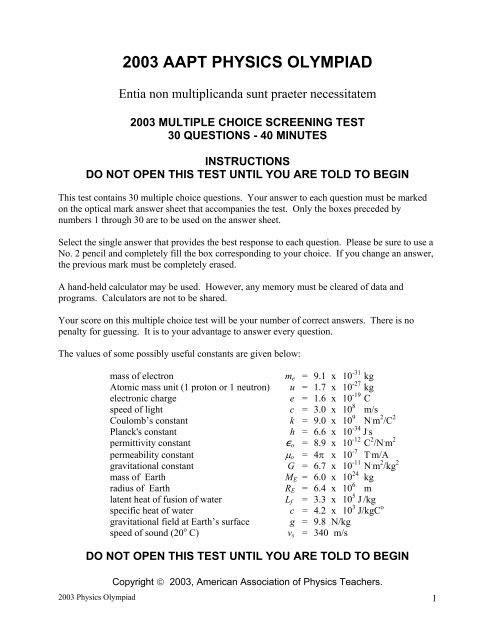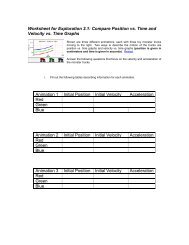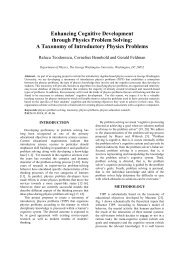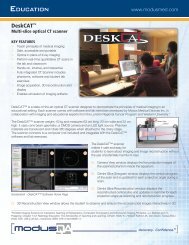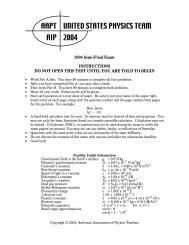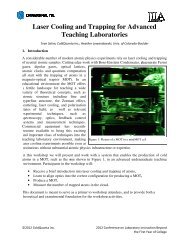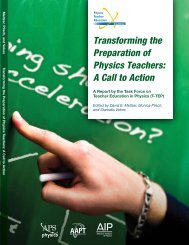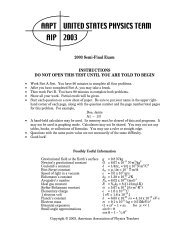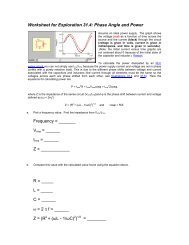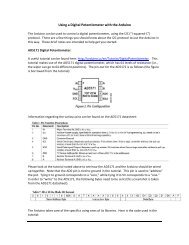2003 AAPT PHYSICS OLYMPIAD - comPADRE
2003 AAPT PHYSICS OLYMPIAD - comPADRE
2003 AAPT PHYSICS OLYMPIAD - comPADRE
Create successful ePaper yourself
Turn your PDF publications into a flip-book with our unique Google optimized e-Paper software.
<strong>2003</strong> <strong>AAPT</strong> <strong>PHYSICS</strong> <strong>OLYMPIAD</strong>Entia non multiplicanda sunt praeter necessitatem<strong>2003</strong> MULTIPLE CHOICE SCREENING TEST30 QUESTIONS - 40 MINUTESINSTRUCTIONSDO NOT OPEN THIS TEST UNTIL YOU ARE TOLD TO BEGINThis test contains 30 multiple choice questions. Your answer to each question must be markedon the optical mark answer sheet that accompanies the test. Only the boxes preceded bynumbers 1 through 30 are to be used on the answer sheet.Select the single answer that provides the best response to each question. Please be sure to use aNo. 2 pencil and completely fill the box corresponding to your choice. If you change an answer,the previous mark must be completely erased.A hand-held calculator may be used. However, any memory must be cleared of data andprograms. Calculators are not to be shared.Your score on this multiple choice test will be your number of correct answers. There is nopenalty for guessing. It is to your advantage to answer every question.The values of some possibly useful constants are given below:mass of electronm e = 9.1 x 10 -31 kgAtomic mass unit (1 proton or 1 neutron) u = 1.7 x 10 -27 kgelectronic chargee = 1.6 x 10 -19 Cspeed of light c = 3.0 x 10 8 m/sCoulomb’s constant k = 9.0 x 10 9 N . m 2 /C 2Planck's constanth = 6.6 x 10 -34 J . spermittivity constant ε o = 8.9 x 10 -12 C 2 /N . m 2permeability constant µ o = 4π x 10 -7 T . m/Agravitational constant G = 6.7 x 10 -11 N . m 2 /kg 2mass of Earth M E = 6.0 x 10 24 kgradius of Earth R E = 6.4 x 10 6 mlatent heat of fusion of water L f = 3.3 x 10 5 J /kgspecific heat of waterc = 4.2 x 10 3 J/kgC ogravitational field at Earth’s surface g = 9.8 N/kgspeed of sound (20 o C)v s = 340 m/sDO NOT OPEN THIS TEST UNTIL YOU ARE TOLD TO BEGINCopyright © <strong>2003</strong>, American Association of Physics Teachers.<strong>2003</strong> Physics Olympiad 1
THE NEXT THREE QUESTIONS REFER TO THE FOLLOWING SCENARIOThree blocks (A, B, and C) are each pushed by equal forces, F, frictionlessly across a horizontalsurface for a distance of 2 meters. The mass of block A is greater than block B, and the mass ofblock B is greater than block C.1. Which block will be traveling the fastest after the 2 meter push?A) Block A D) All blocks will be moving with the same speedB) Block B E) It depends on the actual masses of the blocksC) Block C2. Which of the blocks would have the greatest kinetic energy at the end of the 2 meterpush?A) Block A D) All blocks will have the same kinetic energyB) Block B E) It depends on the actual masses of the blocksC) Block C3. Which of the blocks will have received the greatest impulse during the 2 meter push?A) Block A D) All blocks will have the same impulseB) Block B E) It depends on the actual masses of the blocksC) Block C4. A skydiver is falling at terminal velocity before opening her parachute. After openingher parachute, she falls at a much smaller terminal velocity. How does the total upward forcebefore she opens her parachute compare to the total upward force after she opens her parachute?A) the ratio of the forces is equal to the ratio of the velocitiesB) the ratio of the forces is equal to the inverse ratio of the velocitiesC) the upward force with the parachute will depend on the size of the parachuteD) the upward force before the parachute will be greater because of the greater velocityE) the upward force in both cases must be the same<strong>2003</strong> Physics Olympiad 2
9. A uniform ladder in static equilibrium leans against africtionless wall. The ladder has length L and mass M. Giventhat the angle between the ladder and floor is 30 o degrees, whatwould be the value of the coefficient of static friction (µ s )between the ladder and the ground?A) µ s≥ 1 3B) µ s≥ 2 3D) µ s≥ 1 2E) µ s≥ 3C) µ s≥ 3210. A roller coaster car moves along a track as shown. At point A, the roller coaster car ismoving with a speed of 10 m/s. If friction is negligible, about how fast would the car be movingat point B?A) 14 m/s B) 20 m/s C) 22 m/s D) 26 m/s E) 31 m/s11. A laboratory cart with a mass of m and velocity v runs headlong into a stationary springbumper and compresses the spring. If the spring has a spring constant k, what is the maximumcompression of the spring?A) v m kB)mvk2C) mv 2kD) mv k E)mv2k12. A meter stick is supported at each end by a spring scale. A heavy mass is then hung onthe meter stick so that the spring scale on the left hand side reads four times the value of thespring scale on the right hand side. If the mass of the meter stick is negligible compared to thehanging mass, how far from the right hand side is the large mass hanging?A) 25 cm B) 50 cm C) 67 cm D) 75 cm E) 80 cm<strong>2003</strong> Physics Olympiad 4
THE NEXT TWO QUESTIONS REFER TO THE FOLLOWING SCENARIOA figure skater has a moment of inertia of 4.0 kg . m 2 with her arms outstretched. If she begins aspin at 3.0 rad/s with her arms outstretched and then brings her arms in tight to her body, her rateof spin increases to 7.0 rad/s in 2.5 seconds. You may ignore friction and air resistance.13. As the skater brings her arms in tight to her body, what torque is applied to increase herspin.A) 2.7 N . m D) 9.3 N . mB) 4.0 N . m E) no torque is applied to increase her spinC) 5.3 N . m14. What is the moment of inertia of the skater with her arms tight to her body?A) 0.73 kg . m 2 B) 1.7 kg . m 2 C) 2.8 kg . m 2 D) 7.5 kg . m 2 E) 9.4 kg . m 215. Two identical spheres carry identical electric charges. If the spheres are set a distance dapart they repel one another with a force F. A third sphere, identical to the other two but initiallyuncharged is then touched to one sphere and then to the other before being removed. Whatwould be the resulting force between the original two spheres?A) 3 4 F B) 5 8 F C) 1 2 F D) 3 8 F E) 1 4 F16. A conventional electric current flows due east in a high voltage power line. What wouldbe the direction of the resulting magnetic field directly below the power line?A) north B) east C) south D) west E) up17. Two parallel metal plates 0.04 meters apart are connected to a 1.5 volt battery. Whenfully charged, each metal plate has a charge of magnitude 9.0 x 10 -4 coulombs. What is thecapacitance of the two plates?A) 1.5 x 10 -2 F B) 1.2 x 10 -3 F C) 3.0 x 10 -4 F D) 6.0 x 10 -4 F E) 9.0 x 10 -4 F18. An electron travels so that its total energy is twice its rest energy (0.511 MeV). What isthe speed of the electron?A) v= 1 2 c B) v=3 3c C) v=4 2 c D) v=8 8c E) v=9 3 c19. An alpha particle is accelerated to a velocity v in a particle accelerator by a potentialdifference of 1200 V. Which of the following potential differences would be needed to give thealpha particle twice the velocity?A) 7200 V B) 4800 V C) 4100 V D) 2400 V E) 1700 V<strong>2003</strong> Physics Olympiad 5
20. A battery, an ammeter,three resistors, and a switch areconnected to form the simplecircuit shown to the right.When the switch is closed whatwould happen to the potentialdifference across the 15 ohm resistor?A) it would equal the potential difference across the 20 ohm resistorB) it would be twice the potential difference across the 30 ohm resistorC) it would equal the potential difference across the 30 ohm resistorD) it would be half the potential difference across the 30 ohm resistorE) none of the above21. A sample of an ideal monatomic gas is confined in a rigid 0.008 m 3 container. If 40joules of heat energy were added to the sample, how much would the pressure increase?A) 5 Pa D) 3,333 PaB) 320 Pa E) 5000 PaC) 1,600 PaTHE NEXT TWO QUESTIONS REFER TO THE FOLLOWING SCENARIOA 9-volt battery is connected to four resistors to form a simple circuit as shown below.22. What would be the current at point E in the circuit?A) 2 amp B) 4 amp C) 5 amp D) 7 amp E) 9 amp23. What would be the potential at point B with respect to point D?A) +2 V B) +4 V C) +5 V D) +7 V E) +9 V24. A beam of light from the air is incident on a transparent block of material. The angle ofincidence is 49 o while the angle of refraction is 30 o . What is the velocity of light in thetransparent material?A) 1.8 x 10 8 m/s B) 2.0 x 10 8 m/s C) 2.3 x 10 8 m/s D) 3.0 x 10 8 m/s E) 4.5 x 10 8 m/s<strong>2003</strong> Physics Olympiad 6
25. An electromagnetic wave is moving to the right. At oneinstant at point P, the electric field vector E is pointing towardsthe top of the page. In which direction would the magnetic fieldvector B point at this moment?A) to the rightB) to the leftC) into the paperD) out of the paperE) towards the bottom of the paper26. An object is placed 60 cm from a convex converging lens. The image produced isinverted and half the size of the object. What would be focal length of the lens?A) 90 cm B) 60 cm C) 45 cm D) 30 cm E) 20 cm27. A transmission diffraction grating is ruled with 5000 lines per cm. Through what anglewill the first order maxima be deflected when light with a wavelength of 4.5 x 10 -7 m strikes thegrating at an angle of incidence of 0 o .A) 5.2 o B) 6.4 o C) 13 o D) 27 o E) 34 o28. Non-polarized light first passes through one polarizing filter and then through a second.If the intensity of light emerging from the second filter is 12.5 % of the light that struck the firstfilter, at what angle must the axes of the two filters be with respect to one another?A) 7 o B) 30 o C) 42 o D) 60 0 E) 83 o29. Assume that sodium produces monochromatic light with a wavelength of 5.89 x 10 -7 m.At what rate would a 10 watt sodium vapor light be emitting photons?A) 3.5 x 10 19 photons/s D) 2.0 x 10 19 photons/sB) 3.0 x 10 19 photons/s E) 1.5 x 10 19 photons/sC) 2.5 x 10 19 photons/s30. One object has twice the temperature of a second identical object. How does the rate R 1at which the first object radiates energy compare to the rate R 2 at which the second objectradiates energy?A) R 1 = R 2 B) R 1 = 2R 2 C) R 1 = 4R 2 D) R 1 = 8R 2 E) R 1 = 16R 2<strong>2003</strong> Physics Olympiad 7
2002 <strong>AAPT</strong> <strong>PHYSICS</strong> <strong>OLYMPIAD</strong>Entia non multiplicanda sunt praeter necessitatem<strong>2003</strong> MULTIPLE CHOICE SCREENING TEST30 QUESTIONS - 40 MINUTESAnswers1) C2) D3) A4) E5) D6) B7) D8) A9) C10) C11) A12) E13) E14) B15) D16) A17) D18) C19) B20) C21) D22) A23) A24) B25) D26) E27) C28) D29) B30) E<strong>2003</strong> Physics Olympiad 8


